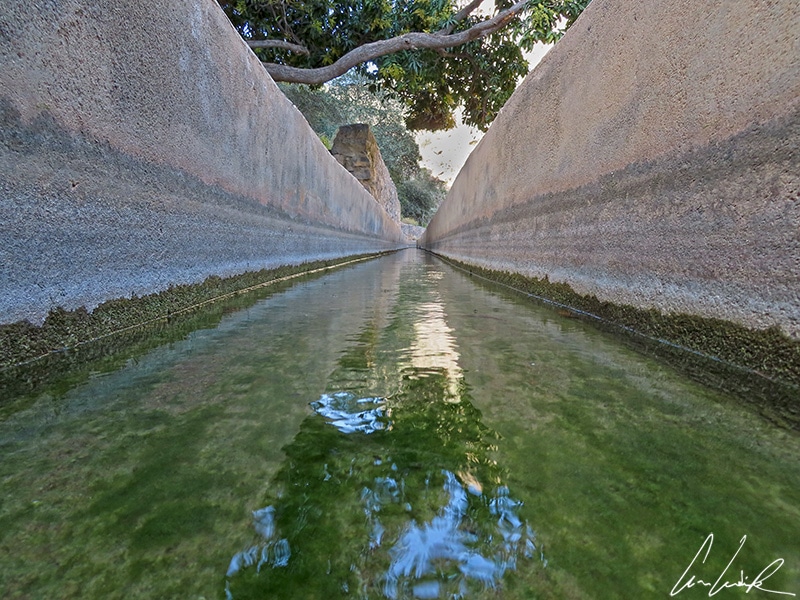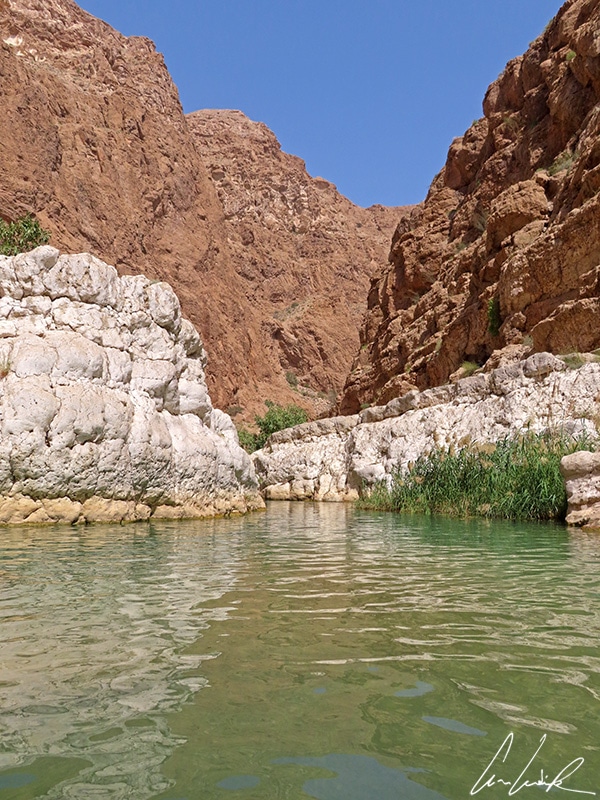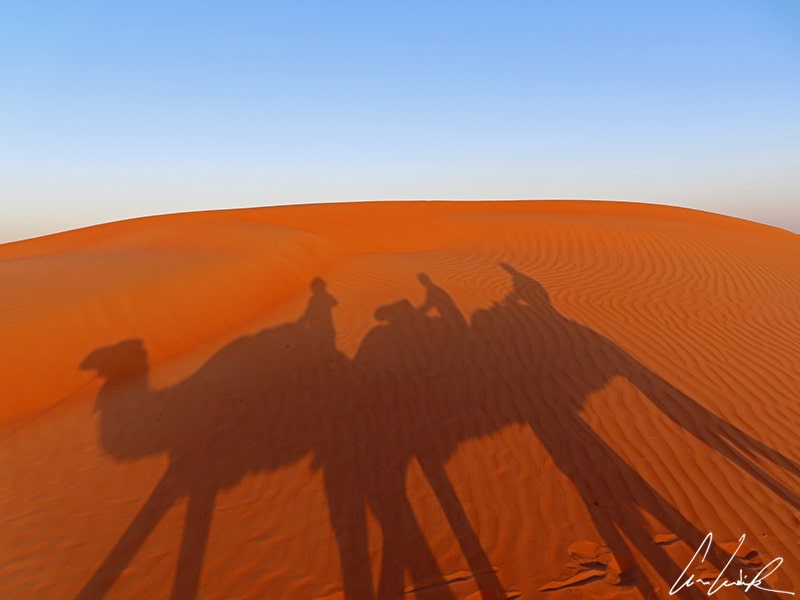Without a doubt Mother Nature gave the Sultanate of Oman her best ! As soon as you leave the city of Muscat, the scenery changes abruptly, and you find yourself in a mineral world of stony plains and jagged mountains. In the 14th century, Ibn Battûta, a Muslim Berber Moroccan explorer nicknamed « the Marco Polo of Islam » described the land in his book, the « Rihla », (or « Travels ») thus: « It is a fertile land with rivers, trees, orchards, palm plantations, and all kinds of fruit ». But how is this possible, you may ask. This description is relevant but only if we view the country through its Wādīs, deep green valleys lined with palm trees that shelter narrow gorges and natural pools and crisscross the mountains. Like oases in the middle of the desert, the Wādīs of the Sultanate of Oman are true treasures, a slice of heaven hidden on earth. And since we’re talking about the desert, make sure you don’t miss the fascinating Wahiba Sands or Sharqiya Sands. This moving desert of 4,800 sq. mi. (12,500 km2) is located in the northeast of the country. A slight breeze shapes the dunes into ever-changing ephemeral patterns. In essence, the desert is, therefore, actually moving, and we find it really moving !
« What makes the desert beautiful is that somewhere it hides a well ».
(Antoine de Saint-Exupéry)
The Wadis of Sultanate of Oman: oases in a mineral desert
Long, deep canyons with vertical walls, the Wādīs, cut into the mountains. In these green settings, date palms, banana trees, lemon trees, and mango trees are often cultivated thanks to the “aflaj” (plural of « falaj » – in Arabic falaj, which means split into parts). The Aflaj are a clever irrigation system nearly 5000 years old. The water flows by gravity from the source to homes and cultivated land. The oldest water channels date back to around 500 AD. But recent archaeological excavations in the Hili oasis of the Al-Ain region have revealed that this irrigation system existed in the area around 2700-2400 BC. In other words, the beginnings of irrigated agriculture go back to the night of time !

Eighty percent of Oman is deserts and mountains, but the Wādīs (Arabic: وَادِي, which means « canyon, valley ») offer visitors a taste of paradise on earth. There’s no apple to bite into, but why not succumb to these pomegranates or dates that Muslims aptly name “Fruits of Paradise.” Dates are the holy fruit of the Middle East. They symbolize generosity and gratitude. They are served to guests are part of the hospitality of every Arab house. Date farming is the main crop in Oman, representing 80% of all fruit produced. The estimated production of dates is 270,000 tons/year, making the Sultanate of Oman, the 8th largest producer of dates in the world, far ahead of Tunisia and Morocco. Oman has over 250 varieties of date palms, but only a dozen or so are prized for their flavor, such as the fresh succulent and sugary khunaizi and the caramel-like khalas. Much of the production is exported to India, southern Iran, and other Gulf countries. Dates are harvested in the early morning. One tree can yield up to 265 pounds of dates. Dates are particularly fragile and usually require drying before being transported. This is why the dates spend about four days in full sun before packaging.

The Wādī Al Arbiyeen is a natural canyon in the Hajar Mountains. The Hajar Mountains in the north of Oman run from the eastern United Arab Emirates to northeastern Oman. They are the highest mountain range in the eastern Arabian Peninsula. The Dhofar Mountains in the south lie between Oman and Yemen. The ochre color of the rocks surrounding the emerald green waters and the absolute calm make Wādī Al Arbiyeen a relaxing place. Enjoy, and let yourself be captivated by the timeless atmosphere that reigns here. Only the sound of the waterfall and the twists and turns of the acrobatic displays of an Indian roller (Coracias benghalensis) break our peace of mind. This bird is easily recognized by its blue crown and vent. In flight the roller displays deep purplish-blue wings with a pale blue band.
« The physical beauty…also cleared her mind of worries. Every day seemed to change the mountain, the sky, and the surrounding valleys, making them spectacular in a completely new way. Nature, at least, didn’t need an operation to be beautiful. It just was ».
(Scott Westerfeld – Uglies)

Another Wādī, similar and yet different, lies in the Hajar Mountains range… Wādī Shab is about 90 minutes-drive from Muscat and 40 minutes north of Sour. Freshwater coming down from the mountains merges with saltwater as this Wādī, nicknamed « the gorge between the cliffs », ends in the Gulf of Oman. After a short boat ride across the river there is a hiking trail that follows the course of a dry river. The hike runs along the Cliffside of the Wādī. As you gradually climb admire the winding gorge with its spectacular dimensions and colors. At the end of the hike, our reward is waiting for us. We discover beautiful blue pools embedded in the vertical white and ochre walls. Around the micro waterfalls, red and blue dragonflies perform aerial acrobatics. Thanks to its two pairs of independent wings, the dragonfly can fly forward, make lightning dives, move backward, flutter and stop dead still to start again in the opposite direction: first prize in aerobatic competitions ! Dragonflies are also able to attain a peak speed of up to 55 mph (90 km/h.) They, along with horseflies, are the fastest insects.

If you want to enjoy a Wādī without any effort, Wādī Bani Khalid is your destination. Wādī Banī Khālid is located at about 126 miles from Muscat and 75 miles from Sour. It is the most popular and best-known Wādī in Oman. The access road winds through beautifully sculptured rock formations tinged with green and rust colors due to the presence of copper oxide and iron ore and ascends the heights of the Eastern Hajar Mountains. It is preferable to go in the morning and to avoid the Omani weekends on Thursday and Friday to escape the crowds. Developed for tourism, bathing is easy in the huge basin of water overhung by a refreshment bar. If you don’t feel like swimming, let your feet splash in the water: you’ll have the joy of seeing dozens of small fish approaching to offer a delightful pedicure.

It is possible to escape the crowds by taking the marked path to the Moqal cave. Going up the river, you will discover beautiful natural pools with small waterfalls, surrounded by oleander. Like a small Garden of Eden, no? Here you can relax and enjoy the narrow gorge and emerald waters.

Wahiba Sands: a desert of moving sans
Another wonder of the Omani landscape, located a three-hour drive south of Muscat, is Wahiba Sands (Arabic: رِمَال وَهِيْبَة or رَمْلَة آل وَهِيْبَة), also known as Sharqiya Sands (Arabic: ٱلرِّمَال ٱلشَّرْقِيَّة). Wahiba Sands is a desert stretching 110 miles north to south and 50 miles east to west, a total area of 4,800 sq. mi. The region, named after the Bedouin tribe of Al-Wahiba, borders the Hajar Mountains and the Arabian Sea. This sea of sand is an immense, moving dune ecosystem. A 1986 expedition by the Royal Geographical Society revealed astonishingly diverse flora and fauna–150 plant specimens and 200 animal species as well as thousands of Bedouins

A night, the desert is magical. Absolute silence reigns. To us, so accustomed are we to noise pollution, it is almost deafening. We are so far away from our artificial world. At night you can enjoy the starry sky, so luminous that the stars seem brighter here than elsewhere. In the early hours of the day, the desert is a dazzling feast of changing colors. The dunes reveal a palette of orange-gold shades that vary in the sunlight. The panorama exposes itself before our astonished eyes: undulations of fine sand, a play of continuous curves, and an impression of infinite space. The two dromedaries (Camelus dromedaries) remained stoic in front of this solar spectacle ! We try to follow the crest of a dune but quickly, our eyes get lost in its immensity. This sea of sand, with its giant mineral waves, is both impressive and peaceful: do nothing, think nothing, remain in complete silence, and admire the beauty of nature…
« I have always loved the desert. One sits down on a desert sand dune. sees nothing. hears nothing. Yet through the silence something throbs and gleams…»
(Antoine de Saint-Exupéry – The little Prince)

The immense rust-colored dunes light up in some places to take on more golden hues. This desert has two types of sand, one of which is finer and lighter and moves across the dunes following the flow of the winds, creating changing hues depending on the time of day. Would this mean that the sand is both frozen for eternity and forever in motion? Shaped by the winds, the dunes are in perpetual motion: it is said that you can get lost in a few minutes in a desert because it changes according to the winds… It is, therefore, impossible to find your way around without the help of a Bedouin guide. « Moo-saa’id ‘ana dayie ! » (Help, I’m lost!)

The Sultanate of Oman evokes the mythical tale « The Thousand and One Nights ». You almost expect to see a magic carpet flying over the dunes followed by a genie coming out of a lamp. But failing to meet Aladdin, Sheherazade, or Ali Baba, we want to learn more about these inhabitants of the desert, people capable of surviving in this inhospitable land. The Bedouins who, thanks to their dromedary camels, live as nomads in search of water sources… but today’s reality is a bit different from the cliché. In the last few years, Bedouins have abandoned some of their nomadic and tribal traditions. They settle near schools and health centers but continue to live in the desert, herding goats, and dromedary camels. The issue of access to water is still central to their life in the desert even though they are now getting water from cisterns carried by four-wheel-drive vehicles. Their immutable hospitality remains as simple as a cup of cardamom « kah-wa »…
Le dromedary camel: an essential element of Bedouin culture
Ask a Bedouin about his most precious possession and he will inevitably tell you about his dromedary camels, regarded as a « gift from God ». The dromedary is a living symbol of Bedouin culture. In the past, desert families had a nomadic way of life in which camels played an essential role. They were not only used as a means of transportation – being able to cover 31 to 62 miles a day at an average speed of 6 to 8 mph – but they had a practical use. They are a source of food, including milk and meat, and are treated as pets. A dromedary lives up to its name and likes to be stroked on the sides of its neck and under its throat. But beware, he has an excellent memory and is vindictive. When he feels threatened, he brings food from his stomach up to his mouth, but, fortunately for us, he does not spit it out, unlike his close cousin, the llama.

Nowadays dromedary camels, having been replaced by motorized transport, are mainly bred for racing. Camel racing is a popular sport, attracting large crowds in all countries on the Arabian Peninsula. Camels race at speeds up to 38mph, dashing to the finish line, watched, on both sides of the track, by air-conditioned four-wheel drive vehicles. Sitting comfortably in their cars, coaches shout encouragement and give instructions to their champions amidst huge clouds of dust.

The dromedary belongs to the Camelidae family, which includes the llama, alpaca, guanaco, and vicuna. It is herbivorous. The dromedary is an even-toed ungulate with a single hump on its back and measures between 5.9 and 6.6 feet at the shoulder and weighs between 880 and 1,320 pounds. This « prince of the desert » is adapted to live in hot, arid environments. Its light-colored coat limits the rise in temperature while insulating from the cold of the night. Its long, double-layered eyelashes prevent sand and dust from entering the eyes and shield them from the sun’s glare. It can close its nostrils voluntarily to protect itself from the sand and avoid water evaporation. Its snout is very particular with an upper lip shorter than the lower lip and split in two by a furrow. This peculiarity makes its upper lip function a bit like two large, agile fingers, thus allowing it to deftly seek out the small tender leaves on thorny bushes, the softest part of these tough plants! Its mouth, lined with scales and sticky saliva, does the rest.

Like the giraffe, a dromedary moves both legs on one side of its body at the same time, swaying from side to side ! Its stride is long and varied, the movement fast. Still, on the other hand, lateral stability is reduced. When a camel lifts one leg, it displays a two-toed footwith a wide plantar surface and an elastic pad that absorbs shocks. These characteristics allow it to walk easily on sandy ground. One could almost compare these wide feet to snowshoes that could be used on the fine, soft sand ! I promise, on my next trip to a desert region, I will take my snowshoes with me for a test. While we are sinking at each step, the dromedary is passing with ease despite its weight. The dromedary leaves behind a wide, round, and barely marked tracks in the sand; it is as if it hardly touches the sand with each step… it lives up to its nickname, « ship of the desert ».
Find more on the Sultanate of Oman
- Muscat, capital of the Sultanate of Oman: A city walk in the anti-Dubai!
- The East Coast of the Sultanate of Oman: A Walk along the Coastline
- Escapes in the Hajar Mountain Range
- The Sultanate of Oman in the time of Castles
- In the early hours of the day, the desert of Wahiba Sands is a dazzling feast of changing colors. under an orange sky, the dunes reveal a palette of orange-gold shades that vary in the sunlight.































